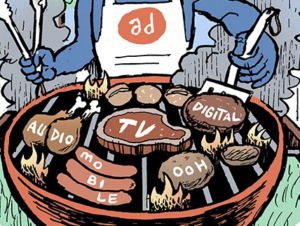“On TV & Video” is a column exploring opportunities and challenges in advanced TV and video.
Today’s column is by Joe Hirsch, general manager of SpringServe.
We’ve all been there. You’re streaming a show, and somehow the same ad for the new Nissan Altima plays four times. Does Nissan really think you need this family sedan, or is it just a glitch in the ad tech matrix?
Compared to linear, CTV’s addressability and targeting make ads more relevant. Yet, this granularity cuts both ways. With streamers becoming increasingly possessive over their data, the CTV ecosystem remains fragmented. This presents a challenge to brands looking to streamline buys and avoid excess ad placement frequency.
CTV could learn from linear’s simplicity. As CTV becomes a dominant platform, advertisers should consider the ingredients that have enabled traditional TV to thrive for as long as it has.
1. Linear TV ad buying is straightforward
Audiences watching traditional cable can expect a seamless viewing experience that blends into programming. They’re unlikely to experience duplicate ads. Part of this has to do with the simplicity of traditional ad buying.
By comparison, the CTV ad stack is complex. There are several hoops a CTV ad has to jump through, from the ad player to the DSP. For linear ads, the entire process is compressed to one piece of software.
This issue is compounded by more streamers becoming “walled gardens” with first-party consumer data. Take, for example, the recent news of NBCUnified. Consequently, there’s no single access point to manage CTV inventory and performance without using multiple platforms.
This generally means a brand can’t have a universal frequency cap or achieve competitive separation across its CTV buys.
2. Linear uses a unified means of measurement
Longstanding television industry benchmarks like Nielsen ratings provide advertisers with a uniform way of tracking ad reach. While Nielsen ratings are much less detailed and nuanced than CTV viewing data, they do offer a unified means of measurement.
The rub for streamers is that most streaming services rely on proprietary measurement systems to quantify ad engagement. To get a clear picture of how an ad campaign is performing across several CTV platforms and streaming services, all these measurement sources must be unified.
More holistic reporting of CTV will continue to be a focus of development in 2022. Finding a common language to communicate viewing data to marketers will accelerate CTV investment and better convey the true value of CTV inventory.
3. Linear’s big-screen scale is “sticky”
With the appointment viewing of linear, there’s natural “stickiness” and word-of-mouth marketing: Everyone’s heard the same jingle or chuckled at the same joke.
While the audience-based targeting of CTV ensures no impression gets wasted, viewing is less communal. No one sees the same ad at the same time. The question becomes, “How do buyers and publishers create big-screen experiences on CTV that rival the ‘stickiness’ of linear?”
To drive brand visibility, brands and publishers should lean into CTV’s unique capacities. For example, unlike broadcast, CTV can serve interactive ads. Imagine a wrapped display ad that frames the screen where audiences choose the episode of a show. Because of its location, viewers naturally have to toggle to it using their smart remote. Strategically using these unique CTV environments can further engage an already highly actionable streaming audience.
Publishers can also take more advantage of the flexibility CTV affords. In traditional TV, publishers have a fixed amount of ad minutes per hour. In CTV, everything’s adaptable. In a perfect world, publishers would proactively manage the user’s CTV ad experience to parse out ads so they’re lighter up front, then increase load once the audience is fully invested in the programming.
An opportunity for optimization
Ultimately, CTV publishers have a tremendous level of flexibility and control over how and when ads are delivered to audiences. The next challenge for CTV will be finding more ways to help publishers and media providers use this control to optimize monetization and improve performance.
While traditional TV buying is largely handicapped by being relatively slow, inflexible, and upfronts-based, CTV offers a premium, agile environment to reach addressable audiences at scale. However, to deliver on its full promise, CTV can learn from the quality standards and practices of traditional broadcast.
Follow SpringServe (@springserve) and AdExchanger (@adexchanger) on Twitter.













